Kinsale is a beautiful harbour town on the south coast of Ireland. It lies in a large bay, watched over by an old fort. And the Wild Atlantic Way begins here…
Page Contents (click line to jump the text)
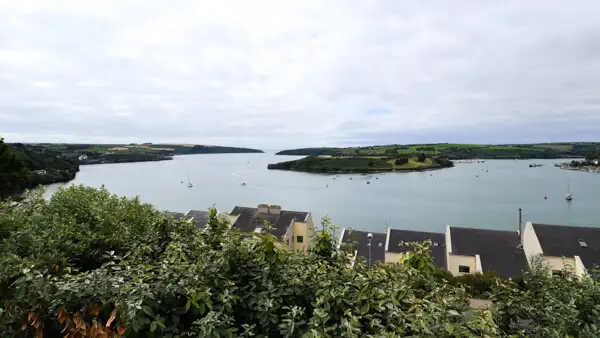
Intro
So, I’ve actually already anticipated everything. Just come and have a look.
Still not convinced? Well, then I’ll tell you a bit more 🙂 :
I’ve only been to Kinsale twice so far, once by car and once by motorbike, but I definitely know I want to come back again.
The south-west of Ireland is incredibly beautiful. Most tourists probably drive straight from Dublin to Killarney to the Ring of Kerry, and then along the coast north to Sligo or Donegal or vice versa. In doing so, they see the west coast and thus about half of the Wild Atlantic Way.
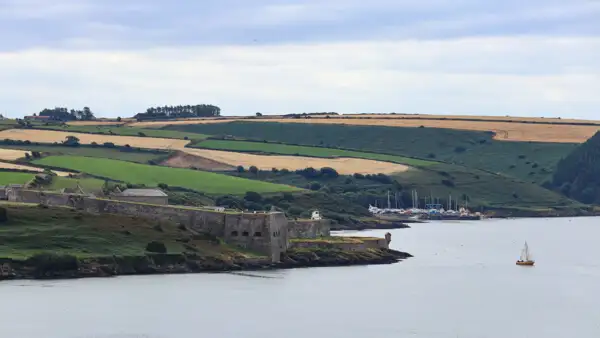
This is a good choice and a beautiful tour. What not everyone sees is the south or the north. The Wild Atlantic Way starts in Kinsale on the south coast and runs for 2600 kilometres along the west coast to Malin Head on the north coast (or vice versa).
If you drive the southern part or the northern part, you will see far fewer people than in the centre (west coast around Galway).
Kinsale is a fantastic starting point for the southern Wild Atlantic Way. From here you can drive the south coast all the way to Baltimore. Take your time and drive the small roads along the coast, along the bays. Ireland is still very unspoilt here and the scenery is particularly beautiful.
Kinsale is no exception: the bay is very large and very sheltered, the town is lively and colourful and the fort on the hill overlooking the bay is well worth seeing.
We have been living in Ireland as a second home for several years (we are originally from Germany) and have travelled the isle many times.
Let’s come back to Kinsale:
Some background about Kinsale
Sheltered bays have always been used as natural harbours on the island of Ireland. This is also the case here – the River Brandon meanders in wide arcs through the hills before it meets the Celtic Sea. It forms a wide estuary that merges into a winding, very large bay.
It is hardly surprising that this bay was not only of interest to fishermen, but also to merchant fleets and war fleets. Where ships dock, money is involved and where there is money, settlements and towns develop – like Kinsale.
In the 16th century, Kinsale maintained trade relations with Spain. At the time, Catholic Spain was at war with Protestant England and allied itself with the Catholic Irish rebels against the common enemy. In 1601, a Spanish armada came to Kinsale to wage war against the English. However, in the following battle, the Battle of Kinsale, the Spanish were crushed by the English, which also marked the suppression of the Irish rebellion (Gaelic Wars).
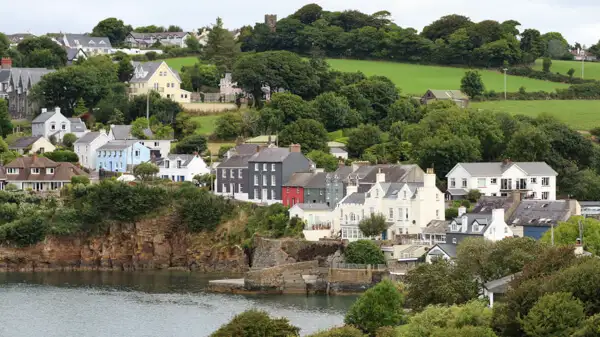
In the years that followed, the Gaelic lords were driven further and further away and the English took over Kinsale. In the following decades, two forts were built in the bay to guard the entrance to the harbour from two sides. The James Fort on the western shore and the Charles Fort on the western shore.
Desmond Castle in the city centre dates back to the 15th century. The Tower House was built by an Irish nobleman as a customs house and later also served as a prison and an armoury during the Battle of Kinsale.
Kinsale was subsequently a naval harbour for a long time before the navy was transferred to Cobh (Cork).
Today, Kinsale lives very much from tourism and has a very large and beautiful marina.
The Charles Fort
Charles Fort is probably the most important sight in Kinsale. It is situated on a hill on the eastern shore of Kinsale Bay. On the opposite shore is James Fort. In the past, a heavy chain could be stretched between the two forts to make it difficult to enter the harbour.
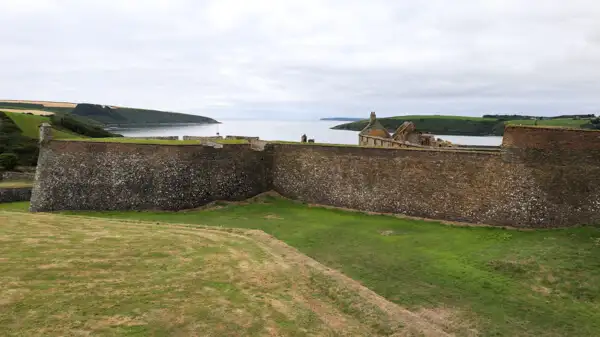
The James Fort is now in ruins, but the Charles Fort is quite well preserved and can be visited from the outside and inside. The walls at the entrance give no idea of how large the fort really is, but it extends all the way to the coast and along it for a while.
The fort is laid out in a star shape with an outer wall and numerous garrison buildings inside. There are numerous artillery bastions along the walls, covering the entire sea side as well as the land sides. See also: https://heritageireland.ie/places-to-visit/charles-fort-military-fortress/.
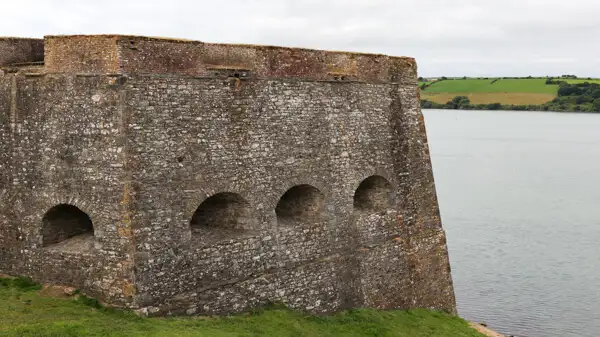
Visiting Kinsale
Kinsale is about 25 kilometres southwest of Cork and you can easily combine the two in one tour.
If you’ve heard the name Cobh, it’s the harbour suburb of Cork. This is where the Titanic docked for the last time before setting sail on its tragic journey across the Atlantic. There is also a small Titanic museum here. See: https://www.titanicexperiencecobh.ie.
In fact, many ships docked here before they (successfully) sailed across the Atlantic. You can also combine Cobh with Kinsale.
To the west of Cork and therefore north of Kinsale is the small town of Blarney, where you will find Blarney Castle. This is a very large castle ruin with beautiful gardens and huge parks.
But the real highlight (in my personal opinion) is the south-west coast.
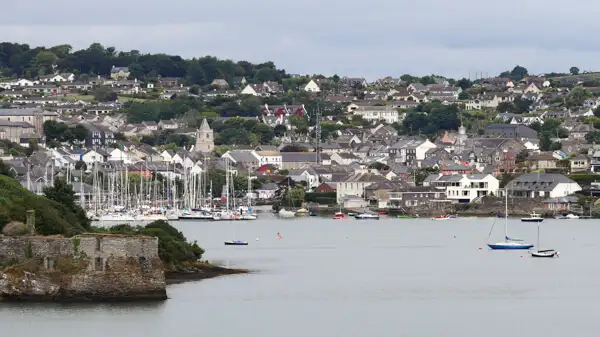
So if you drive westwards from Kinsale and spend as much time as possible by the water and in the small bays, you will experience beautiful corners and stretches of coastline that not everyone sees.
Kinsale itself is a touristy place. It can get quite busy in summer, which is certainly also due to the large marina. The advantage: there are plenty of places to stay and very good restaurants and bars here and the townscape with its narrow streets and colourful houses is very pretty to look at.
An evening stroll in Kinsale and a nice meal and drink at the harbour – pure holiday feeling! Unfortunately, I didn’t take any photos in the town – but I’ll do that on my next visit, I promise!
What else you can see in the area
Old Head of Kinsale
The Old Head of Kinsale is a rocky headland to the west of Kinsale. Rugged cliffs jut out into the Celtic Sea. A lighthouse stands on the cliffs, defying the wind. Just in front of it is a golf course in this breathtaking setting. You can visit the cliffs there and also the small Lusitania Museum. The Lusitania was a sister ship of the Titanic. See: http://www.oldheadofkinsale.com.
Charles Fort
I have already described the Charles Fort near Kinsale in the text above, see: https://heritageireland.ie/places-to-visit/charles-fort-military-fortress/.

Desmond Castle Kinsale
You can find more information about Desmond Castle Kinsale here: https://heritageireland.ie/places-to-visit/desmond-castle-kinsale/.
Nohaval Cove
Nohaval Cove is a small, wildly romantic, rocky cove a little to the west of Kinsale. A beautiful photo spot!
Drombeg Stone Circle
This is a thousand-year-old stone circle and a ritual site of druids. It is located a little to the west of Kinsale, near Glandore. You can find my article about it here: https://irland-insider.de/der-drombeg-stone-circle-das-steinerne-erbe-irlands/.
Knockdrum Stone Fort
The Knockdrum Stone Fort is also “as old as stone” and is located near Castletownshend, not far from Drombeg. See also: http://www.megalithicireland.com.
Titanic Experience Cobh
Cobh is known from Instagram, where there are probably thousands of photos of a colourful row of houses with a cathedral behind them. It’s always the same photo spot – you can do it… Alternatively, you can also visit the Titanic exhibition, see: https://www.titanicexperiencecobh.ie. There is also the Cobh Heritage Centre, which is also very much about seafaring. see: https://www.cobhheritage.com.
Conclusion
There’s not much more to add, I think. Except: Kinsale Town is very beautiful, the bay is marvellous and Kinsale is a really wonderful starting point for the southern Wild Atlantic Way.
If you have more time, you can also follow the Wild Atlantic Way over 2600 kilometres to the northern end, Malin Head. And if you’re already there, then just add another week to it and drive around the entire island of Ireland – good plan? I think so!
I wish you lots of fun in Kinsale!
More interesting articles for you
BLARNEY CASTLE AND THE STONE OF ELOQUENCE
DROMBEG STONE CIRCLE – THE MEGALITHIC HERITAGE OF IRELAND
HOOK HEAD LIGHTHOUSE – THE OLDEST ACTIVE LIGHTHOUSE IN THE WORLD
WATERFORD AND THE VIKINGS
Picture credits cover picture: Kinsale town and harbor, photo: Ulrich Knüppel-Gertberg (www.irland-insider.de, www.ireland-insider.com)